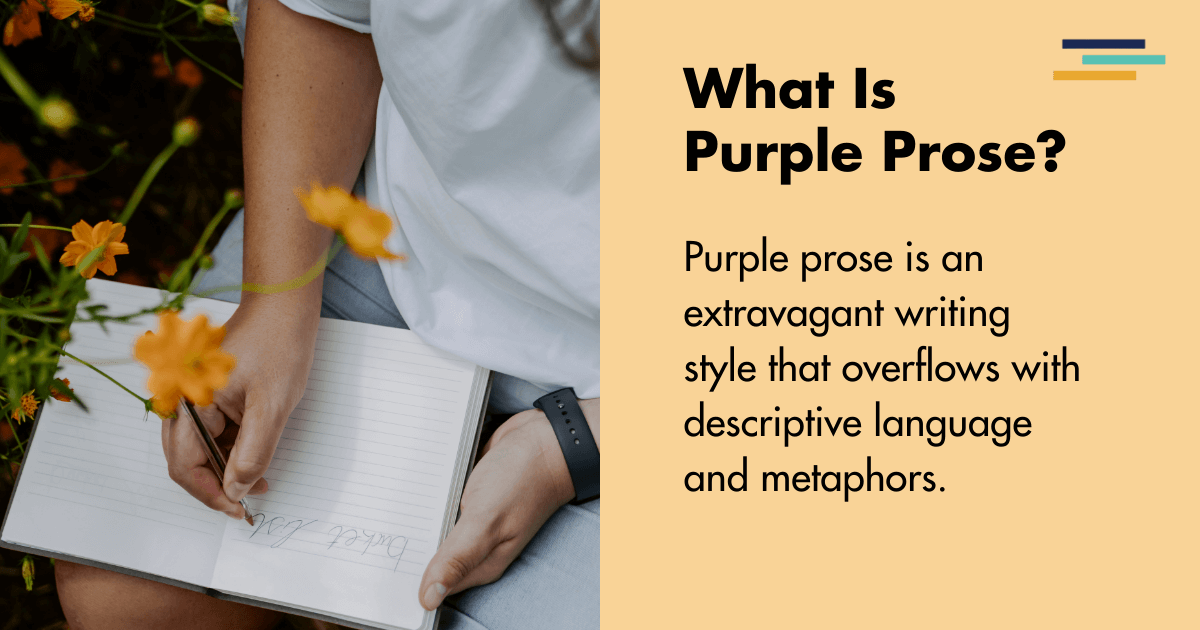
Ah, purple prose—a term that might make you think of a literary color palette gone wild.
But what exactly is it?
Purple prose is an extravagant writing style that overflows with descriptive language and metaphors. Imagine a rich, decadent dessert with layers upon layers of sweetness… while initially appealing, it can quickly become overwhelming.
What Is Purple Prose?
Purple Prose Definition
In literature, purple prose drowns out the narrative with its overly elaborate expressions, making it hard for readers to grasp the core of the story.
Purple prose often includes an abundance of adjectives and adverbs, long and complex sentence structures, and a heavy reliance on metaphors and similes. This style can create a sense of grandeur and depth, but can also obscure the clarity of the narrative, leaving readers lost in a sea of words.
It’s like navigating through a dense forest where every tree is so thick with leaves and branches that you can’t see the path ahead.
Purple Prose Meaning
Let’s dive deeper into the meaning and origins of this colorful term.
The phrase “purple prose” harks back to the Roman poet Horace, who waxed lyrical about overly ornate passages in literature as “purple patches” in his work Ars Poetica.
These passages stood out unnaturally against the rest of the text, much like a bright purple cloth sewn into a plain garment. Over time, the term grew to describe writing that’s excessively adorned and difficult to digest because of its heavy use of adjectives, adverbs, and flowery language.
Historically, purple has been associated with royalty and opulence, partly because of the rarity and cost of purple dye in ancient times. This association with luxury and excess naturally extended to the term “purple prose,” implying a kind of writing that is rich to the point of being excessive.
Writers who fall into the trap of purple prose often prioritize style over substance, focusing more on how the text sounds rather than what it communicates.
Epic fail.
Purple prose can often stem from a writer’s desire to impress their readers with their linguistic prowess. New writers, in particular, might think that using elaborate language and intricate sentence structures will make their work stand out. However, this can backfire if the prose becomes so convoluted that it detracts from the story’s plot, characters, and themes.
In modern writing, critics often see purple prose as a sign of amateurism.
Editors and readers alike favor clear, concise writing that communicates the story effectively without unnecessary embellishment. However, there are still writers who can pull off a more ornate style without losing the reader, proving the key lies in balance and context.

Purple Prose Examples
Sometimes, the best way to understand something is to see it in action, or in this case, in literature. Let’s explore a few famous examples of purple prose. Buckle up, because we’re about to enter a world of lavish language.
Ninth House by Leigh Bardugo (2019)
Leigh Bardugo’s Ninth House ventures into purple prose with its detailed descriptions of Yale’s secret societies and the dark magic that permeates the story.
The book’s opening lines set the tone with a richly described scene, for example: “By the time
Alex managed to get the blood out of her good wool coat, it was too warm to wear it. Spring had come on grudgingly; pale blue mornings failed to deepen, turning instead to moist, sullen afternoons, and stubborn frost lined the road in high, dirty meringues. But sometime around mid-March, the slices of lawn between the stone paths of Old Campus began to sweat themselves free of snow, emerging wet, black, and tufty with matted grass, and Alex found herself notched into the window seat in the rooms hidden on the top floor of 268 York, reading Suggested Requirements for Lethe Candidates.”
Bardugo’s prose immerses the reader in the gothic, mysterious atmosphere, but the density of the language can sometimes make the story harder to follow.
Bardugo’s detailed world-building and atmospheric descriptions are strengths of her writing, drawing readers into a vividly realized setting. However, when the prose becomes too elaborate, it can obscure the action and slow the narrative pace.
Striking the right balance is crucial, and Bardugo’s work offers valuable lessons in both the strengths and pitfalls of purple prose.
Gideon the Ninth by Tamsyn Muir (2019)
Tamsyn Muir’s Gideon the Ninth is known for its unique blend of genres and its highly descriptive prose.
The novel’s detailed descriptions of the necromantic world and its characters often border on purple prose, for example: “Out here, you had an unimpeded view up to a pocket of Ninth sky. It was soupy white where the atmosphere was pumped in thickest, and thin and navy where it wasn’t. The bright bead of Dominicus winked benignly down from the mouth of the long vertical tunnel.”
Muir’s writing style creates a vivid and engaging world, but the density of the prose can sometimes be overwhelming.
Muir’s ability to create a richly textured world is a key aspect of the book’s appeal. However, the elaborate descriptions can also pose a challenge for readers, making it easy to lose track of the story amid the lush language.
This highlights the fine line between effective, evocative prose and purple prose that detracts from the narrative.
The Ten Thousand Doors of January by Alix E. Harrow (2019)
Alix E. Harrow’s The Ten Thousand Doors of January features a lyrical writing style that often veers into purple prose.
Harrow uses intricate descriptions of the magical doors and the worlds they lead to, for example: “When I was seven, I found a Door. There look how tall and proud the word stands on the page now, the belly of that D like a black archway leading into white nothing.”
The prose creates a sense of wonder and enchantment, but it can also be dense and challenging to navigate.
Harrow’s skill in crafting beautiful, imaginative descriptions is clear throughout the novel. However, the richly detailed prose can sometimes overwhelm the reader, making it harder to focus on the story’s progression.
This underscores the importance of balance in writing, ensuring that descriptive language enhances rather than hinders the narrative.
Is Purple Prose Bad?
Now that we’ve waded through some rich examples, you might wonder, “Is purple prose really that bad?”
The answer isn’t black and white.
Purple prose can be a double-edged sword. On one hand, it can create lush, immersive worlds and evoke powerful emotions. On the other, it can bog down the narrative, making it hard for readers to connect with the story.
Excessive descriptions can pull readers out of the action, causing them to lose interest.
When every page is packed with ornate language, it can become a chore to read. However, when used sparingly and effectively, purple prose can add a touch of magic and depth to your writing.
One of the major criticisms of purple prose is that it can feel self-indulgent. Writers who use this style excessively might seem more interested in showcasing their vocabulary and creative flair than in telling an interesting story. This can alienate readers, who might struggle to find the core of the narrative amid the decorative language.
On the flip side, some readers and critics appreciate the artistry of purple prose.
When done well, it can transform a simple story into a rich tapestry of words, creating a memorable and immersive experience. Critics praise authors like Vladimir Nabokov and Gabriel Garcia Marquez for their ornate writing styles, which contribute to the unique voice and atmosphere of their works.
Ultimately, whether purple prose is “bad” depends on its execution and the context in which it’s used.
In genres like fantasy and historical fiction, where elaborate world-building and evocative descriptions are valued, purple prose might be more acceptable than in fast-paced thrillers or contemporary fiction. The key is to use descriptive language purposefully, enhancing the story without overwhelming it.

Tips for Avoiding Purple Prose
So, how do you strike the right balance?
Here are some tips to help you avoid falling into the purple prose trap while still keeping your writing vivid and engaging.
- Prioritize Clarity: Keep your primary goal in sight. Clear communication. If a sentence is more about showcasing your vocabulary than advancing the story, consider simplifying it. Remember, your primary goal is to tell a story that your readers can easily follow and enjoy.
- Be Selective with Descriptions: Choose your moments for detailed descriptions. Save the ornate language for scenes that truly need it and keep other parts of your writing straightforward and to the point. Descriptions should enhance the story, not distract from it.
- Use Strong Verbs and Nouns: Instead of piling on adjectives and adverbs, use precise verbs and nouns to convey your meaning. “He sprinted” is more effective than “He ran quickly.” Strong, specific language can paint a clear picture with no excessive embellishment.
- Read Aloud: Reading your work aloud can help you catch overly elaborate passages. If you get lost or trip over words, it’s a sign you might need to pare down the prose. Hearing your words can help you identify areas where the language is too dense or convoluted.
- Seek Feedback: Sometimes, we’re too close to our own work to see its flaws. Get feedback from beta readers or writing groups to help identify and trim any purple prose. Fresh eyes can offer valuable insights and help you see your writing from a different perspective.
- Study the Masters: Look at how accomplished authors balance description with narrative drive. Pay attention to how they use language to enhance, rather than overshadow, the story. Analyzing the work of writers you admire can provide inspiration and guidance for your own writing.
- Edit Ruthlessly: In the editing phase, be prepared to cut or revise passages that don’t serve the story. It’s often said that “writing is rewriting,” and this is true for eliminating purple prose. Be willing to make tough choices to improve the overall readability and impact of your work.
By keeping these tips in mind, you can create vivid, engaging prose without falling into the trap of purple prose. The goal is to enhance your story, not to overshadow it with overly elaborate language.
And finally, always remember that story comes first. Use purple prose to help you:
- Create engaging characters
- Pen interesting plots
- Structure solid settings
A tool like Fictionary helps you turn your draft into an interesting story readers love. So, with the right prose and a strong narrative foundation, your writing can truly shine.


